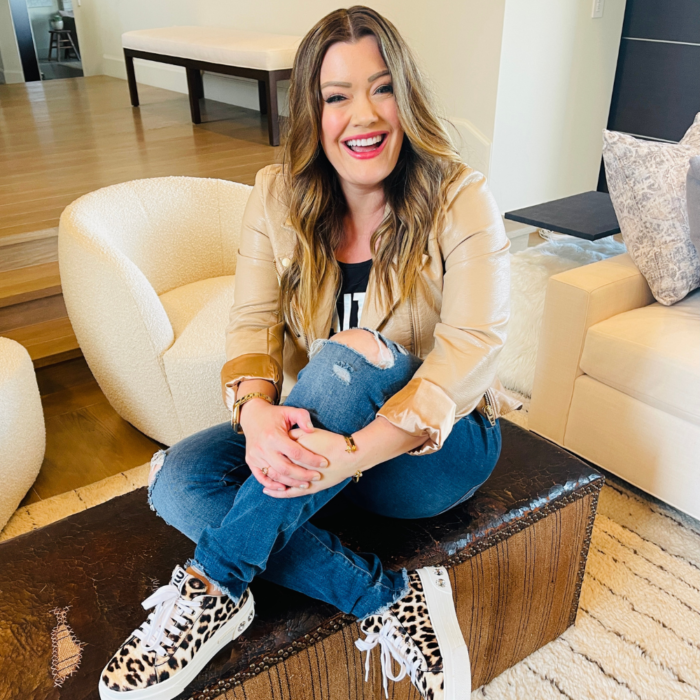Foundr Magazine publishes in-depth interviews with the world’s greatest entrepreneurs. Our articles highlight key takeaways from each month’s cover feature. We talked with Jamie Kern Lima, founder of IT Cosmetics, about how a last-minute decision led to a multi-billion dollar business. To read more, subscribe to the magazine.
——
Jamie Kern Lima sat in her parked car outside the QVC studios in West Chester, Pennsylvania. She watched people walk in and out of the building and began to cry.
For two years, she had sent samples of her makeup brand, IT Cosmetics, to the live shopping network only to meet with rejection. In fact, she had been sending her products to every outlet she could think of without much success.
“I believed in them so much. And you know, I sent them to every retailer, every department store, every beauty retailer, and online retailer QVC,” Lima, the CEO and co-founder of the now multibillion-dollar company, says. But a chance meeting at a trade show with a QVC host finally put her on their radar.
Now, she would have just one 10-minute spot to sell her products. She and her husband, Paulo, who is also a co-founder, had sunk all their money into this one shot.
They had taken out a loan to buy 6,000 units from their manufacturer, the minimum QVC said they needed for the slot. And what they didn’t sell, they would have to take back. Up until that point, they had only been selling two or three products a day on the website Paulo had built using a book from the Dummies series.
The next time she walked through those doors, her life would be changed. She just didn’t know which way it would go. If the units sold, it would be the beginning of a new chapter for the company. If they didn’t, the company would be bankrupt.
Solving Her Own Problem
IT Cosmetics started, like so many successful companies, as a solution to Lima’s own problems. Lima suffers from rosacea, a skin condition that causes redness, visible blood vessels, and small bumps on the face.
“My cheeks, my forehead, my nose—everything would get really, really red and bumpy,” Lima says.
As a student at the University of Washington, she worked at a Safeway supermarket and as a server at Denny’s. “I started spending my entire paycheck on products. I tried everything out there from the most expensive to the least expensive, and nothing would work.”
After graduating from Columbia Business School, Lima landed her dream job as a morning news anchor in her home state of Washington. But her makeup was no match for the hot studio lights.
One day, while she was on the air, her producer came on her earpiece.
“There’s something on your face. Wipe it off.”
It was her rosacea. The studio lights were causing her makeup to break apart, and there was nothing she could do about it. She feared she would be fired if she didn’t find something that worked under the HD lights.
“I had a big problem that I couldn’t solve.”
“And I kind of had this big ‘aha’ moment where I was like, ‘Oh my gosh, there’s hundreds of companies out there that do this and none of them work for me.”
She figured if they didn’t work for her, there must be other people out there who had the same problem.
In 2007, on the plane to their honeymoon in South Africa, she and her husband sketched out the business plan for IT Cosmetics. When they got back, Lima quit her job as a news anchor, and they launched the company out of their living room.
Betting on the ‘Why’
The next year, after partnering with plastic surgeons and dermatologists, she had her first products.
She pitched and sent samples wherever she could, but no one was biting. The company began to struggle. They built a website and launched a direct-to-consumer (DTC) model, but even then, only a few orders trickled in each day, and that was after weeks of no orders at all.
“It’s broken,” she recalls telling her husband, who had built the site from scratch. “There’s no way this website’s working. We’re just getting no orders. The product is too good. This went on and on and on. And then I’ll never forget the day of our very first order. I was screaming and running around the living room, so excited.”
Read more: How MaryRuth Ghiyam Built a Wellness Empire
Now, here she was, taking a shot on QVC and praying her products would sell.
For a moment, she contemplated backing out of the segment because she was so worried she would run into more rejection. After all, if the makeup didn’t start to sell in the first two minutes of the segment, QVC would pull the plug and move to another product.
The pressure was almost too much.
But Lima had stuck by her product this long because she knew what her “why” was.
“We hear so many amazing thought leaders talk about your ‘why’ and identifying the ‘why’ of your business, your brand, your mission,” Lima says.
“What I know now, because I’ve had the gift of meeting thousands of entrepreneurs over the years, [is] their ‘whys’ aren’t strong enough. They haven’t actually done the work to peel back the layers and go deeper.”
Lima had dug deeper into her “why” at the inception of the company. On the surface, she had created IT Cosmetics figuring that if she had a problem finding makeup that covered her rosacea, other people probably had the same problem.
But then she had started thinking about the beauty industry as a whole and her struggles with beauty standards. She thought back to her childhood, watching the actresses on television and looking at the perfect models in magazines.
“I aspired to look like that. But [on] a real deep level, they always made me feel like I wasn’t enough,” she says.

But what if she could do it differently?
“When I launch a beauty company, what if I can actually use real people,” she says. “ … All different ages and sizes and shapes and skin tones and skin challenges. And what if I can actually shift the definition inside the entire industry?”
Her company didn’t follow the aspirational model nearly all other beauty brands ascribe to. And there lay the obstacle to selling her product. But it also made her brand stand out.
QVC or Bust
Lima went ahead with her segment, remembering her mission and the audience she was there for.
“I kept imagining this single mom folding laundry who was too busy to remember she was beautiful and that she mattered,” she says. “And I just had this moment, like, you know what? I would rather have her turn on the television and give me five seconds of her time … even if she buys nothing. I’d rather stand for that than sell a bunch of products and stand for nothing. And so I knew what I had to do.”
“But we know what we have to do is often not the easy thing.”
She had wanted to wipe her makeup off on air to show the audience that even the CEO used the products to cover her own skin condition; that even she wasn’t perfect. But QVC said no, giving Lima a success model to follow.
As her segment began and the clock started counting down, Lima broke from the script. She wiped her makeup off to reveal the rosacea, which had been concealed completely by her makeup.
By the end of the segment, all 6,000 units had sold out.
QVC is still one of IT Cosmetics’ biggest channels.
The Importance of Being Authentic
Lima took a big risk wiping her makeup off on camera. But if there’s one thing Lima believes has truly carried her brand, it’s her authenticity as a spokesperson and as a CEO.
“I think inauthenticity guarantees failure.”
“It was when the person they had on air was the same on air as they were in the green room, whether they were extroverted or introverted or wild or it didn’t matter, but there’s that sort of congruence and authenticity that you can take and feel it. And so the people that were truly authentic when they were in the room but then also live is the person that the customer would connect with.”
The second you start to dilute your authenticity, Lima says, is the moment you and your company are in trouble.
After the QVC spot, the company grew rapidly. The next year, Lima did 250 live shows for QVC. That’s on top of serving as CEO of a company that was scaling quickly and bringing new products to market.
Lima dove in, taking a hands-on role in every part of her company.
“One of the things I was never able to truly figure out for myself was how to not become totally burnt out,” she says. “I drove everything so hard, including myself.”
The sudden success of the company took a toll on both her and her husband. Lima found herself becoming, as she describes it, indifferent to its success, something that threatened the authenticity she had worked so hard to build for the brand.
Then, L’Oréal came knocking.
The post How Jamie Kern Lima Used 10 Minutes to Create a Billion-Dollar Business — Exclusive appeared first on Foundr.








